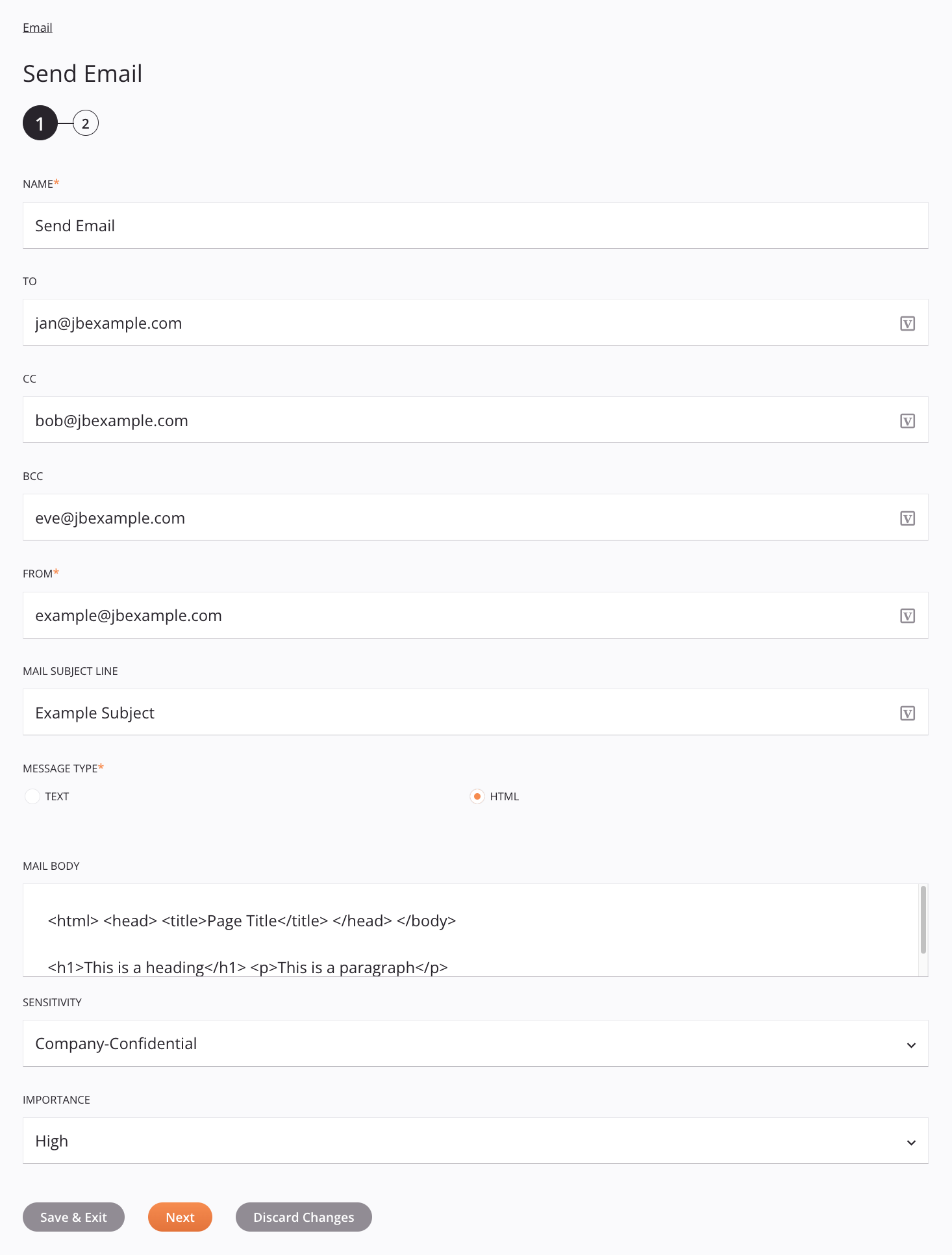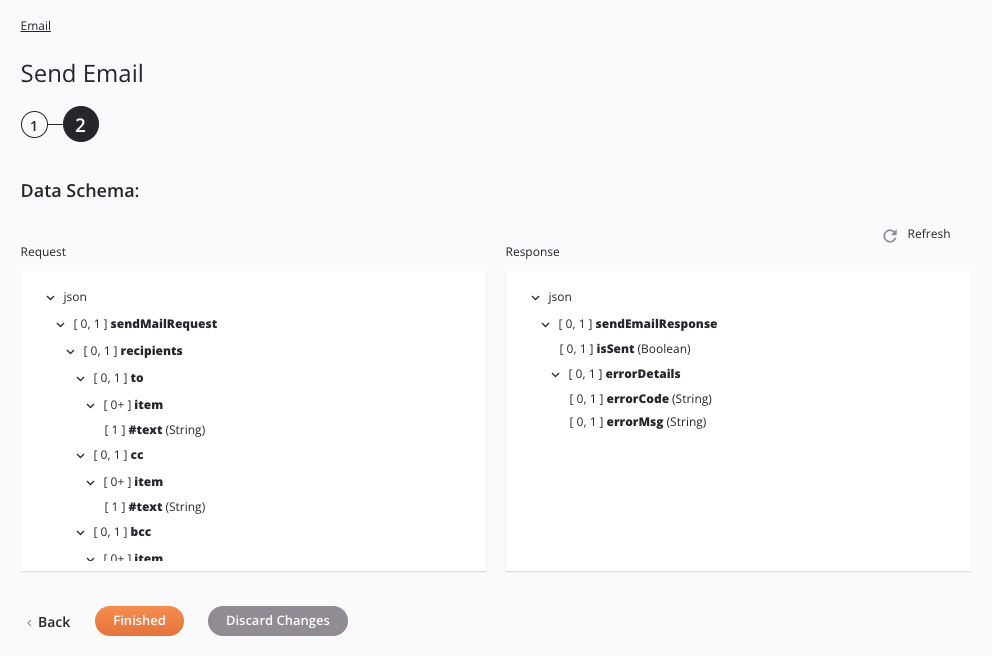Email send email activity¶
Introduction¶
An Email Send Email activity, using its Email connection, sends email using the Simple Mail Transfer Protocol (SMTP) to specified recipients and is intended to be used as a target in an operation.
Important
To send emails through Microsoft 365 (smtp.office365.com), OAuth2 must be selected for Authentication Type and ROPC (Resource Owned Password Credentials) must be selected for Grant Type in an Email connection.
Create an email send email activity¶
An instance of an Email Send Email activity is created from an Email connection using its Send Email activity type.
To create an instance of an activity, drag the activity type to the design canvas or copy the activity type and paste it on the design canvas. For details, see Creating an activity instance in Component reuse.
An existing Email Send Email activity can be edited from these locations:
- The design canvas (see Component actions menu in Design canvas).
- The project pane's Components tab (see Component actions menu in Project pane Components tab).
Configure an email send email activity¶
Follow these steps to configure an Email Send Email activity:
-
Step 1: Enter a name and specify settings
Provide a name for the activity and specify the settings for the outgoing email. -
Step 2: Review the data schemas
Any request or response schemas generated from the endpoint are displayed.
Step 1: Enter a name and specify settings¶
In this step, provide a name for the activity and specify the settings for the outgoing email. Each user interface element of this step is described below.

Tip
Fields with a variable icon ![]() support using global variables, project variables, and Jitterbit variables. Begin either by typing an open square bracket
support using global variables, project variables, and Jitterbit variables. Begin either by typing an open square bracket [ into the field or by clicking the variable icon to display a list of the existing variables to choose from.
-
Name: Enter a name to identify the activity. The name must be unique for each Email Send Email activity and must not contain forward slashes
/or colons:. -
To: Enter a comma-separated email addresses of recipients to receive the email.
-
CC: Enter the comma-separated email addresses of recipients to receive a copy of the email.
-
BCC: Enter the comma-separated email addresses of recipients to receive a blind copy of the email.
Note
If the same email address is present in two or more of the To, CC, or BCC fields, an error will occur.
-
From: Enter the email address from which recipients will receive the email.
-
Mail Subject Line: Enter the subject line of the email.
-
Message Type: Select the message type of the Mail Body, either Text or HTML.
-
Mail Body: Enter the body of the email in the format of the selected Message Type.
-
Sensitivity: When using Microsoft mail services (such as Microsoft 365 or Outlook), you can optionally select the sensitivity level of the email, one of Company-confidential, Normal, Personal, or Private:
-
Company-confidential: When this option is selected, the text Please treat this as Confidential is displayed in the email's information bar.
-
Normal: When this option is selected, no text is displayed in the email's information bar.
-
Personal: When this option is selected, the text Please treat this as Personal is displayed in the email's information bar.
-
Private: When this option is selected, the text Please treat this as Private is displayed in the email's information bar.
-
-
Importance: When using Microsoft mail services (such as Microsoft 365 or Outlook), you can optionally select the importance of the email, either High or Low. When either of these options is selected, an indicator is present on the email in the recipient's inbox.
-
Save & Exit: If enabled, click to save the configuration for this step and close the activity configuration.
-
Next: Click to temporarily store the configuration for this step and continue to the next step. The configuration will not be saved until you click the Finished button on the last step.
-
Discard Changes: After making changes, click to close the configuration without saving changes made to any step. A message asks you to confirm that you want to discard changes.
Note
Input is required in at least one of the recipient fields To, CC, or BCC unless a transformation supplies the request.
Step 2: Review the data schemas¶
Any request or response schemas generated from the endpoint are displayed. Each user interface element of this step is described below.

-
Data Schemas: These data schemas are inherited by adjacent transformations and are displayed again during transformation mapping.
Note
Data supplied in a transformation takes precedence over the activity configuration.
The request and response data schemas consist of these nodes and fields:
Request Schema Node/Field Description sendMailRequestNode of the email request recipientsNode of recipients toNode of recipients of the email "to" field itemNode of the item of recipients of the email "to" field #textString value of a single "to" recipient email address ccNode of recipients of the email "cc" field itemNode of the item of recipients of the email "cc" field #textString value of a single "cc" recipient email address bccNode of the item of recipients of the email "bcc" field itemNode of the item for recipients to receive a blind copy of the email #textString value of a single "bcc" recipient email address fromString of the email "from" field subjectString of the email "subject" field mailBodyString of the email "body" field
Note
Variables can be supplied in this field.
messageTypeString of the message type, such as textorHTMLattachmentsNode of email attachments
Note
Size limits on attachments apply. See your email server's documentation for information on the enforced size limits.
itemNode of email attachments item fileNameString of the email attachment filename base64contentString of the base64-encoded attachment content
Tip
You can use Jitterbit's
Base64Encodefunction to encode attachment content.sensitivityThe sensitivity level of the email, one of company-confidential,normal,personal, orprivateimportanceThe importance of the email, either highorlowResponse Schema Node/Field Description sendEmailResponseNode of the email response isSentBoolean of whether the email was sent ( true) or not (false)errorDetailsNode of the error details errorCodeString of the error code returned by the email server errorMsgString of the error message returned by the email server -
Refresh: Click the refresh icon
 or the word Refresh to regenerate schemas from the Email endpoint. This action also regenerates a schema in other locations throughout the project where the same schema is referenced, such as in an adjacent transformation.
or the word Refresh to regenerate schemas from the Email endpoint. This action also regenerates a schema in other locations throughout the project where the same schema is referenced, such as in an adjacent transformation. -
Back: Click to temporarily store the configuration for this step and return to the previous step.
-
Finished: Click to save the configuration for all steps and close the activity configuration.
-
Discard Changes: After making changes, click to close the configuration without saving changes made to any step. A message asks you to confirm that you want to discard changes.
Next steps¶
After configuring an Email Send Email activity, complete the configuration of the operation by adding and configuring other activities, transformations, or scripts as operation steps. You can also configure the operation settings, which include the ability to chain operations together that are in the same or different workflows.
Menu actions for an activity are accessible from the project pane and the design canvas. For details, see Activity actions menu in Connector basics.
Email Send Email activities can be used as a target with these operation patterns:
To use the activity with scripting functions, write the data to a temporary location and then use that temporary location in the scripting function.
When ready, deploy and run the operation and validate behavior by checking the operation logs.